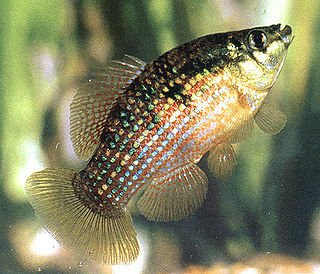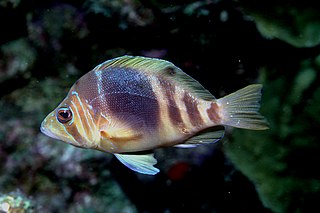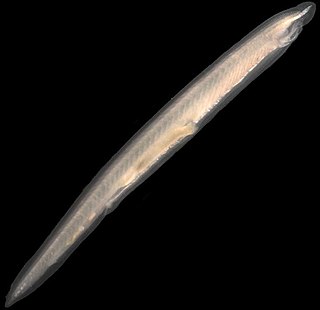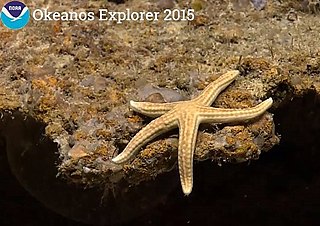
Hypoplectrus is a genus of fishes commonly known as hamlets, found mainly in coral reefs in the Caribbean Sea and the Gulf of Mexico, particularly around Florida and the Bahamas. They are a popular choice for hobbyist saltwater aquariums, and come in a variety of colors.

The lancelets, also known as amphioxi, consist of some 30 to 35 species of "fish-like" benthic filter feeding chordates in the order Amphioxiformes. They are the modern representatives of the subphylum Cephalochordata. Lancelets closely resemble 530-million-year-old Pikaia, fossils of which are known from the Burgess Shale. Zoologists are interested in them because they provide evolutionary insight into the origins of vertebrates. Lancelets contain many organs and organ systems that are closely related to those of modern fish, but in more primitive form. Therefore, they provide a number of examples of possible evolutionary exaptation. For example, the gill-slits of lancelets are used for feeding only, and not for respiration. The circulatory system carries food throughout their body, but does not have red blood cells or hemoglobin for transporting oxygen. Lancelet genomes hold clues about the early evolution of vertebrates: by comparing genes from lancelets with the same genes in vertebrates, changes in gene expression, function and number as vertebrates evolved can be discovered. The genome of a few species in the genus Branchiostoma have been sequenced: B. floridae,B. belcheri, and B. lanceolatum.

The flagfish, also known as the American flagfish or Florida flagfish, is a pupfish, a type of killifish, from the family Cyprinodontidae which is endemic to Florida. It is found in the aquarium trade. Its common name derives from the dominant males' body pattern, which bears some resemblance to the Flag of the United States.

Syngnathus is a genus of fish in the family Syngnathidae found in marine, brackish and sometimes fresh waters of the Atlantic, Indian and Pacific Ocean. Fossils of these species are found from the Oligocene to the Pleistocene. They are known from various localities of Greece, Italy, Germany and United States.
Algae eater, also called an algivore, is a common name for many bottom-dwelling or algae-eating species that feed on algae. Algae eaters are important for the fishkeeping hobby and many are commonly kept by hobbyists.
Chordate genomics is the study of the evolution of the chordate clade based on a comparison of the genomes of several species within the clade. The field depends on whole genome data of organisms. It uses comparisons of synteny blocks, chromosome translocation, and other genomic rearrangements to determine the evolutionary history of the clade, and to reconstruct the genome of the founding species.

Hypoplectrus puella, the barred hamlet is a species of marine ray-finned fish, a sea bass from the subfamily Serraninae which is part of the family Serranidae, which also includes the groupers and anthias. This species is from the Western Central Atlantic. It occasionally makes its way into the aquarium trade.

Branchiostoma is one of the few living genera of lancelets. It is the type genus of family Branchiostomatidae.
Branchiostoma floridae, the Florida lancelet, is a lancelet of the genus Branchiostoma. The genome of this species has been sequenced, revealing that among the chordates, the morphologically simpler tunicates are actually more closely related to vertebrates than lancelets. An embryo of a Florida amphioxus has a larval pharynx with gill slits that is asymmetrical. The gill slits in the larval pharynx form in the center of the embryo when it is in its earliest stage of development (primordial) meaning the thick layer of endoderm is overlapped by a thin layer; which aids into making the B. floridae asymmetrical from left to right. The lancelet Branchiostoma floridae maintains a high level of Fox transcription factor gene diversity, with 32 distinct Fox genes in its genome, and 21,229 clusters of cDNA clones, making it very useful to the research community.
The dusky pipefish is a species of the pipefishes, widespread in the western Atlantic from the Bermuda, Chesapeake Bay, northern part of the Gulf of Mexico, Bahama, and the western Caribbean Sea to Panama in south. Marine subtropical demersal fish, which lives at the depth up to 22 metres (72 ft), usually up to 4 metres (13 ft). The maximal length of the fish is 25 centimetres (9.8 in).

Acanthoscelides is a genus of bean weevils of the subfamily Bruchinae. They are native to the New World. About one third of them can be found in Mexico.
Clivina floridae is a species of ground beetle in the subfamily Scaritinae. It was described by Csiki in 1927.
Geomysaprinus floridae is a species of clown beetle in the family Histeridae. It is found in North America.
Geomysaprinus is a genus of clown beetles in the family Histeridae. There are at least 20 described species in Geomysaprinus.
Acanthoscelides floridae is a species of leaf beetle in the family Chrysomelidae. It is found in the Caribbean region, Central America, and North America.
Phruronellus is a genus of North American araneomorph spiders first described by R. V. Chamberlin in 1921. Originally placed with the Liocranidae, it was moved to the Corinnidae in 2002, and to the Phrurolithidae in 2014.
Aeletes floridae is a species of clown beetle in the family Histeridae. It is found in the Caribbean Sea and North America.
Cytochrome P450, family 11, also known as CYP11, is a chordate cytochrome P450 monooxygenase family. This family contains many enzymes involved in steroidogenesis, such as Cholesterol side-chain cleavage enzyme (CYP11A1), Steroid 11β-hydroxylase (CYP11B1) and Aldosterone synthase (CYP11B2). CYP11 can be divided into A to E five subfamilies, and CYP11A are the ohonologues to CYP11C, which duplicated during 2R event, and the tetrapod's CYP11B evolved from CYP11C of its fish ancestors, CYP11D and F found in amphioxus. These are not the typical CYP subfamilies, which share at least 40% amino acid identity, members between CYP11A and B subfamily are only 37.5-38.8% identical, and the CYP11D and E genes seen in modern lancelet is 39% identical to catfish CYP11A1.

Tamaria is a genus of echinoderms belonging to the family Ophidiasteridae.







